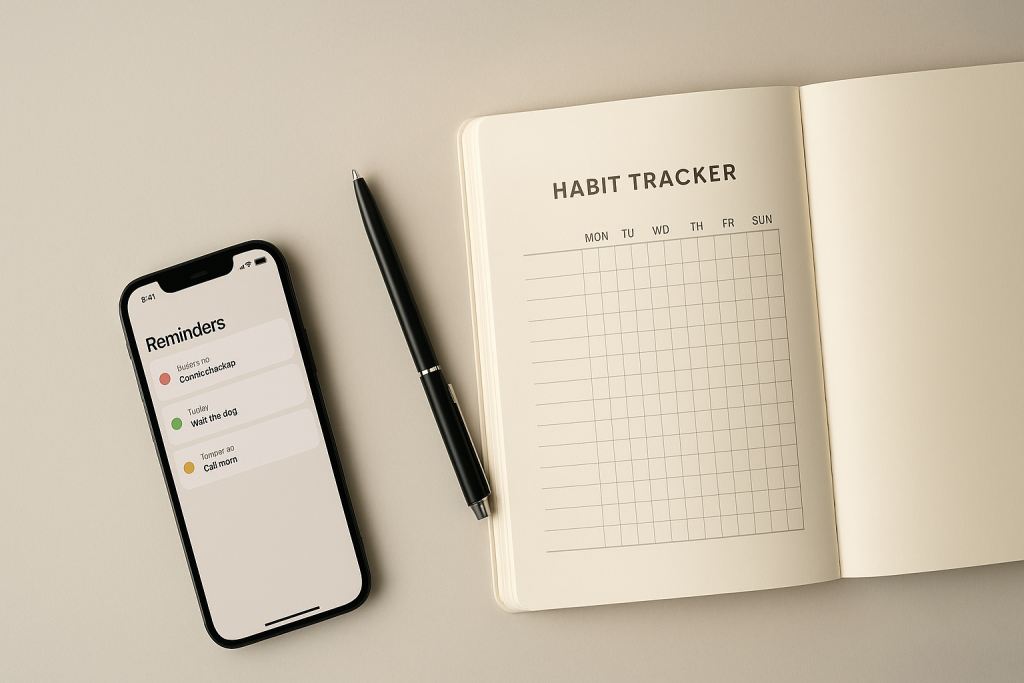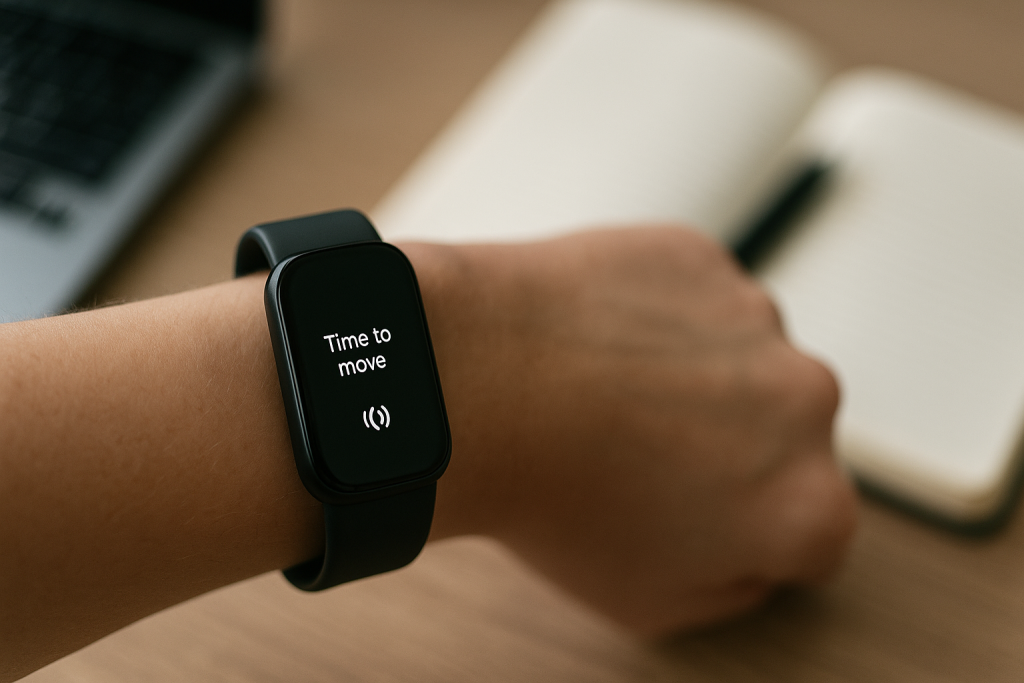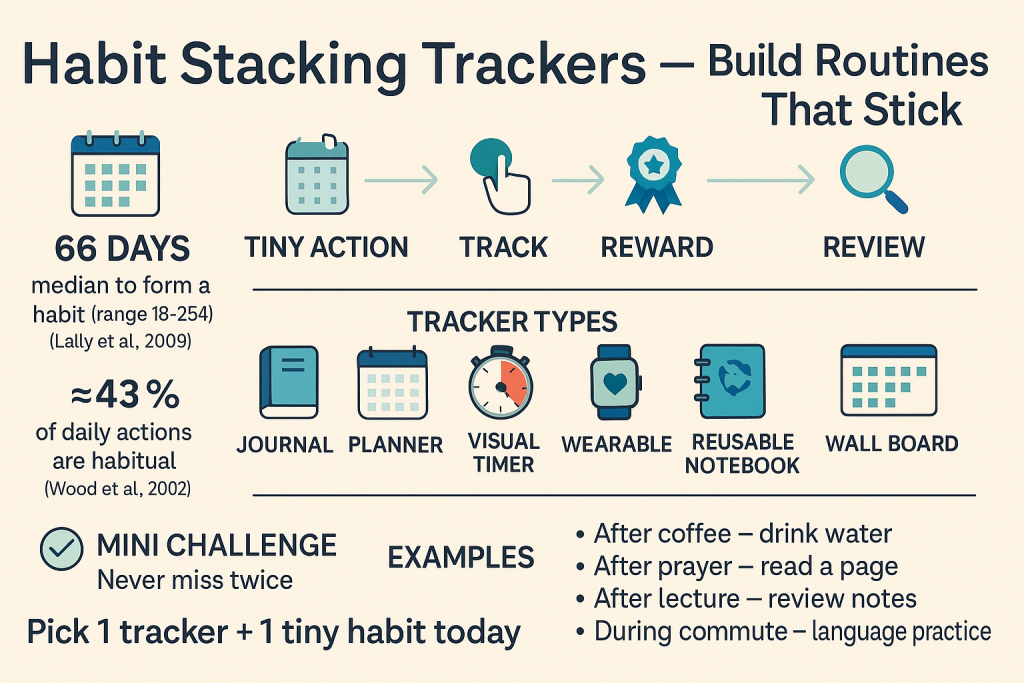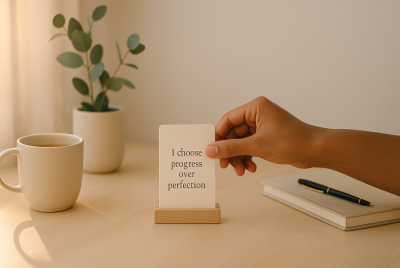7 Habit Stacking Trackers: The Trick to Build a Better Routine
We may earn a commission for purchases made using our links. Please see our disclosure to learn more.
You know that feeling when your day gets hijacked before 10 a.m.? Same. For years I tried to “willpower” my way into better habits…and failed by lunchtime. What finally worked wasn’t grit—it was pairing tiny actions to the habits I already do every day (wake up, make coffee, brush teeth). That’s habit stacking. And with the right Habit Stacking Trackers, you can turn those small links into an effortless, repeatable routine that actually sticks.
In this guide, I’ll show you exactly how to use trackers to build stacks, review 7 smart tracker options (journals, planners, timers, even a wearable), and help you choose the one that fits your lifestyle and culture—whether your morning starts with barako coffee in Manila, a quick prayer, a school run, or a Zoom calendar that never ends.
What Is Habit Stacking (and Why It Works)
Habit stacking is simply attaching a new behavior to a behavior you already do. Picture this—once I brew coffee, I follow it with a glass of water. After I pray Fajr, I’ll read one page of a book. A tracker makes those links visible, repeatable, and rewarding.
Why Use Habit Stacking Trackers Instead of “Trying Harder”
- Visibility: You see your stack, step by step.
- Simplicity: One cue triggers the next action—less decision fatigue.
- Feedback: Trackers give quick wins (streaks, checkboxes, timers).
- Accountability: A page, board, or wearable that reminds you, “Hey, this is who you’re becoming.”
How to Choose the Right Tracker (Quick Fit Guide)
- Paper person? Choose a journal/planner you’ll enjoy opening daily.
- Tech-forward? Pick a reusable smart notebook or a wearable nudger.
- Need momentum? Visual timers are magic for “just start” sessions.
- Family or team? A wall board makes shared stacks obvious.
- On a budget? A simple undated tracker pad works beautifully.
Mini challenge: Which habit will you “piggyback” onto something you already do today?

The 7 Best Habit Stacking Trackers (and How to Use Each One)
These are popular products you can find on Amazon. I’ll break down features, pros/cons, best use cases, and how each supports stacking. Buttons below are ready for your affiliate link.
1) Habit Nest Habit Tracker Journal (Undated)
Why it helps stacking: Structured daily pages + prompts = clear cue → action → review loop.
- Features
- Guided daily/weekly pages, habit grids, reflection prompts
- Undated (start anytime), sturdy binding
- Educational tips on building habits
- Guided daily/weekly pages, habit grids, reflection prompts
- Pros
- Very easy to follow; encourages reflection
- Great for building multi-step stacks
- Very easy to follow; encourages reflection
- Cons
- Fixed layouts may feel rigid for heavy customizers
- Slightly thicker than minimalist notebooks
- Fixed layouts may feel rigid for heavy customizers
- Best for
- Beginners who want coaching baked into the pages
- Anyone building wellness or study stacks
- Beginners who want coaching baked into the pages
- What buyers often say
- “The prompts keep me consistent.”
- “Love that I can start mid-month.”
- “The prompts keep me consistent.”
2) Clever Fox Habit Tracker (Journal/Planner)
Why it helps stacking: Flexible habit grids + weekly reviews—great for linking small habits to anchor routines.
- Features
- Habit/streak grid, goal pages, monthly/weekly reviews
- Colorful stickers for motivation, elastic closure
- Habit/streak grid, goal pages, monthly/weekly reviews
- Pros
- Fun, visual, and beginner-friendly
- Affordable and giftable
- Fun, visual, and beginner-friendly
- Cons
- Stickers aren’t everyone’s style
- Paper weight varies by edition
- Stickers aren’t everyone’s style
- Best for
- Visual learners, students, and anyone who loves color-coded stacks
- Visual learners, students, and anyone who loves color-coded stacks
- What buyers often say
- “Seeing streaks motivates me.”
- “The layout keeps me organized.”
- “Seeing streaks motivates me.”

3) Panda Planner Pro (Undated)
Why it helps stacking: Daily priorities + habit boxes help you line up a cue (e.g., breakfast) with the next small action (journal for 2 minutes).
- Features
- Daily priorities, schedule, habit tracking, reflection
- Science-informed layout for productivity and gratitude
- Daily priorities, schedule, habit tracking, reflection
- Pros
- Excellent for work + life stacks (deep work, breaks, recovery)
- Clean, professional design
- Excellent for work + life stacks (deep work, breaks, recovery)
- Cons
- Narrower habit section than a dedicated tracker
- Requires daily page use for full benefit
- Narrower habit section than a dedicated tracker
- Best for
- Busy professionals and entrepreneurs
- Busy professionals and entrepreneurs
- What buyers often say
- “Helps me focus on important first.”
- “My mornings finally have a rhythm.”
- “Helps me focus on important first.”
4) BestSelf Co. SELF Journal
Why it helps stacking: 13-week sprints create a natural window to build and cement a stack (e.g., pray → read one page → journal one line).
- Features
- 13-week focus, daily/weekly structure, progress tracking
- Goal mapping, gratitude, time blocks
- 13-week focus, daily/weekly structure, progress tracking
- Pros
- Perfect length to form habits without overwhelm
- Encourages review + iteration
- Perfect length to form habits without overwhelm
- Cons
- Some prefer full-year planners
- Time blocks may feel structured for creative schedules
- Some prefer full-year planners
- Best for
- Creatives, freelancers, students in exam seasons
- Creatives, freelancers, students in exam seasons
- What buyers often say
- “Quarterly focus made habits stick.”
- “Love the reflection cadence.”
- “Quarterly focus made habits stick.”
5) Rocketbook Core (Smart Reusable Notebook)
Why it helps stacking: Reusable pages + cloud upload = write your stack once, scan to your phone, and have your routine everywhere.
- Features
- Erasable pages, app scanning to cloud (Drive, Dropbox, etc.)
- Templates available (habit grids, checklists)
- Erasable pages, app scanning to cloud (Drive, Dropbox, etc.)
- Pros
- Eco-friendly and endlessly reusable
- Great for digital backup and sharing
- Eco-friendly and endlessly reusable
- Cons
- Needs Pilot FriXion pens; slight dry time
- Not a pre-printed habit system—you’ll add templates
- Needs Pilot FriXion pens; slight dry time
- Best for
- Tech-savvy minimalists; hybrid paper–digital workflows
- Tech-savvy minimalists; hybrid paper–digital workflows
- What buyers often say
- “Love scanning to my phone.”
- “Templates make it super flexible.”
- “Love scanning to my phone.”
6) Time Timer MOD (Visual Timer)
Why it helps stacking: A visible countdown lowers friction: After I make tea, I’ll do a 10-minute stretch while the red disk disappears. Perfect “start trigger.”
- Features
- Quiet visual countdown, durable case, easy dial
- 1–60 minute range, no loud ticking
- Quiet visual countdown, durable case, easy dial
- Pros
- Powerful for focus, chores, movement micro-sessions
- Helpful for kids and neurodivergent users
- Powerful for focus, chores, movement micro-sessions
- Cons
- Single-purpose (not a planner)
- Requires a bit of desk space
- Single-purpose (not a planner)
- Best for
- Pomodoro, reading, cleaning bursts, prayer prep, language drills
- Pomodoro, reading, cleaning bursts, prayer prep, language drills
- What buyers often say
- “Finally start things without dread.”
- “Visual time just clicks.”
- “Finally start things without dread.”
7) Fitbit Inspire 3 (Activity & Wellness Tracker)
Why it helps stacking: Gentle nudges to move, breathe, or wind down. Stack micro-habits to walks, prayers, meals, or commutes.
- Features
- Steps, heart rate, sleep, stress cues, guided breathing
- Long battery life; app-based streaks/challenges
- Steps, heart rate, sleep, stress cues, guided breathing
- Pros
- Passive reminders; great for movement + mindfulness stacks
- Easy to wear; minimal setup
- Passive reminders; great for movement + mindfulness stacks
- Cons
- App ecosystem required
- Not ideal if you dislike wearables
- App ecosystem required
- Best for
- Movement, hydration, breathwork, posture checks
- Movement, hydration, breathwork, posture checks
- What buyers often say
- “The nudge I needed to hit 8K steps.”
- “Breathing reminders calm me down.”
- “The nudge I needed to hit 8K steps.”
Quick Comparison: Which Tracker Fits Your Life?
| Product | Best For | Format | Key Strength | Potential Tradeoff |
| Habit Nest Habit Tracker | Beginners, wellness stacks | Guided journal | Coaching prompts keep you going | Layout is fixed |
| Clever Fox Habit Tracker | Visual learners, students | Journal/planner | Colorful habit grids & stickers | Aesthetics not for everyone |
| Panda Planner Pro | Work + life balance | Planner | Priorities + habit boxes | Smaller habit section |
| BestSelf SELF Journal | 13-week sprints | Journal | Short cycles build habits fast | Not a full-year system |
| Rocketbook Core | Paper + cloud users | Reusable notebook | Scan & reuse templates | Needs specific pens |
| Time Timer MOD | Focus & “start” energy | Visual timer | Low-friction action cue | Single-purpose device |
| Fitbit Inspire 3 | Movement & mindfulness | Wearable + app | Passive nudges & streaks | Must like wearables |
How to Build Your First Habit Stack in 5 Minutes
- Pick an anchor habit you already do daily (coffee, prayer, school drop-off).
- Add one tiny action (10 air squats, 1 page reading, 1-minute breath).
- Track it visibly with your chosen tool.
- Reward quickly (tick a box, sip tea, text a friend a ✅).
- Repeat daily in the same context—same cue, same place.
Reflection question: What’s the smallest version of your new habit you’d do even on your worst day?
Real-World Stacks for Different Lifestyles
- Busy parent: After packing lunches → 2-minute stretch → check water bottle → gratitude line.
- Student: After opening laptop for class → 10-minute review → set Time Timer for 25 minutes → 5-minute walk.
- Remote pro: After morning standup → 15-minute deep work sprint → log streak → refill water.
- Faith-based routine: After prayer → read one page → journal one line → send a kind message.
- Wellness focus: After brushing teeth → floss → breathe for 60 seconds → take vitamins.
Common Stacking Mistakes (and Simple Fixes)
- Too big, too soon.
- Fix: Shrink to a 30–60 second version you can’t refuse.
- Fix: Shrink to a 30–60 second version you can’t refuse.
- Vague cues.
- Fix: Tie to a precise anchor (“after I put the mug in the sink…”).
- Fix: Tie to a precise anchor (“after I put the mug in the sink…”).
- No feedback loop.
- Fix: Use streaks, checkmarks, or a timer chime to “close” the loop.
- Fix: Use streaks, checkmarks, or a timer chime to “close” the loop.
- Cultural mismatch.
- Fix: Build stacks around your daily rhythms—school runs, prayer times, siesta, tea breaks, commute.

How to Review Your Stack Weekly (10 Minutes, Tops)
- Skim your tracker. Where did you miss?
- Ask why. Wrong cue? Too big? Wrong time of day?
- Shrink or swap. Make it laughably easy or link to a stronger anchor.
- Celebrate streaks. Rewards wire the loop.
- Add one new link only when the last one feels automatic.
🧪 Research-Backed Reasons Trackers Boost Habit Stacks
- If-then planning helps action happen. A landmark meta-analysis found that forming “implementation intentions” (e.g., If it’s after dinner, then I’ll prep tomorrow’s lunch) significantly improves goal achievement. See the classic review: meta-analysis on implementation intentions.
- Habits become automatic with consistent cues. Real-world research shows automaticity typically builds over weeks with repetition in stable contexts—your stack provides that context. Read: real-world habit formation study.
- Self-monitoring works. Systematic reviews indicate self-monitoring (what trackers do) is a powerful behavior-change technique across domains like movement and sedentary time. See: self-monitoring systematic review & meta-analysis.
- Digital tools often rely on feedback + self-monitoring. A recent review of digital behavior change interventions highlights feedback and self-monitoring as core ingredients—useful if you pair a wearable with a journal. Overview: systematic review of standalone digital interventions.
Sample 7-Day Starter Plan (Use Any Tracker Above)
- Day 1: Choose one anchor habit + one tiny add-on.
- Day 2: Set an if-then plan (write it): After coffee, 1-minute stretch.
- Day 3: Add a Time Timer 5-minute focus burst after the stretch.
- Day 4: Track hydration after lunch (Fitbit reminders help).
- Day 5: Add a 30-second gratitude note in your journal at bedtime.
- Day 6: Review streaks; shrink any step that feels heavy.
- Day 7: Celebrate and plan next week (same cue, same place).
Mini challenge: For one week, never miss two days in a row. If you miss once, restart smaller the next day.
FAQs
What’s the ideal count of habits to stack initially?
Start with one tiny add-on to a strong anchor. When it feels automatic (low effort, few misses), add one more. Quality over quantity.
What’s the best time of day to build stacks?
Whenever your anchor behavior is already consistent—morning coffee, commute, school pickup, or evening prayer. Consistency beats clock time.
Are paper trackers better than apps?
Paper often wins for focus and frictionless check-offs; apps win for nudges and data. Many people pair a journal with a wearable for the best of both.
How much time until a behavior feels automatic?
It varies by person and behavior. Research suggests weeks of repetition in a stable context build automaticity—your stack creates that context.
What if I slip up?
Shrink the habit to 30–60 seconds and relink it to the same anchor. Consistency first, intensity later.
Plan Goals That Support Your Stacks
Before you add more links to your routine, make sure your goals are crystal clear. Use this goal-setting worksheet to define outcomes and metrics that align with your stacks.
Conclusion: Small Links, Big Life
The right Habit Stacking Trackers make good intentions tangible. Pick a tool that matches your personality—journal, timer, wearable—and build one tiny link at a time. In a month, you’ll have a routine that runs on rails. In a year, you’ll have a life you’re proud of—built quietly, one stack at a time.




